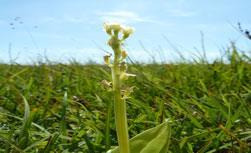The group is no longer active and information on this page is not current and is for reference purposes only.
This is the information page for the WBP Coastal Ecosystem Group. The Coastal Ecosystem Group activities relate to the following Section 7 priority habitats in Wales: Coastal Saltmarsh; Coastal Vegetated Shingle; Coastal Sand Dunes; Maritime Cliff and Slopes
Welsh coastal habitats are a priority for nature conservation supporting a variety of specialised species. They are fragile, dynamic environments and under pressure from land use changes. Sand dunes, vegetated shingle, maritime slope and saltmarsh are the priority coastal habitats in Wales, each supporting common and specialist species including the nationally scarce fen orchid (Liparis loeselii).
Coastal Priority Habitats in Wales
The WBP Coastal Group has identified priority areas for targeted conservation effort in Wales which are listed below. The area maps are also available in GIS format. Use the contact us link to request the files.
The Coastal Group draws its membership from a range of statutory, local authority and wildlife charities and is currently chaired by Angus Garbutt, Centre for Ecology & Hydrology (CEH). If you require a full membership list of the group, please contact the group chair.
Do you have a question relating to the work of this group? contact us
- Sand dune habitat synopsis
- Saltmarsh priority habitat map (North Wales)
- Sand dune priority habitat map (South Wales)
- Saltmarsh habitat synopsis
- Saltmarsh priority habitat map (North Wales)
- Saltmarsh priority habitat map (south Wales)
- Soft cliff habitat synopsis
- Soft cliff priority habitat map Gwynedd
- Soft cliff priority habitat map Ceredigion
- Soft cliff priority habitat map Pembrokeshire
- Soft cliff priority habitat map Gower
- Soft cliff priority habitat map Vale of Glamorgan
- Maritime hard cliff habitat synopsis
- Maritime hard cliff habitat map (North Wales)
- Maritime hard cliff habitat map (south Wales)
Fen orchid- a Welsh botanical treasure
Fen orchids (Liparis loeselii) are one of the most threatened plants in north-west Europe. The sand dune systems at Kenfig National Nature Reserve near Bridgend are a UK stronghold for the species. The fen orchid has been lost from Whiteford Burrows on Gower and outside of Wales it only occurs on a few sites in East Anglia. A radical programme to support fen orchid at the Kenfig site involves scraping away dune vegetation to create dune slacks- a preferred habitat for the species. The on-going work supported by Welsh Government funds involves NRW, Plantlife, Bridgend Council and the Wales Biodiversity Partnership coastal ecosystem group and will help secure the future of this threatened species.
If you would like to submit a biodiversity-related or ecosystem approach evidence gap to this group please contact us
If your gap could be addressed through research activity/ a specific research project, please visit the Evidence Gaps Project page and click on the link 'Formulating Questions for Scientific Research'
- Wales Sand Dune update 2015
- Sand dune rejuvenation in Wales presentation
- The importance of coastal sand dunes for terrestrial invertebrates in Wales and the UK
- Ecological Effects of Re-building Beaches on Intertidal Habitats in Wales
- Coastal Group work plan (draft)
- Coastal Action Framework (draft)
- UK Coastal habitats
- Coastal habitat research
- Coastal Ecosystem Group Meeting January 2016
- Coastal Ecosystem Group Meeting June 2015
- Coastal Ecosystem Group Meeting January 2015
- Coastal Meeting June 2014
- Coastal Meeting January 2014
- Coastal Meeting July 2013
- Coastal Ecosystem Group Meeting 8 November 2012
- Coastal Meeting 7 April 2012
- Coastal Ecosystem Group Meeting December 2011
- Coastal Ecosystem Group Meeting June 2011
- Coastal Ecosystem Group Meeting December 2010
- Coastal Meeting July 2010
- Coastal Meeting January 2010
- Coastal Ecosystem Group Meeting July 2009
- Coastal Ecosystem Group Meeting February 2009















